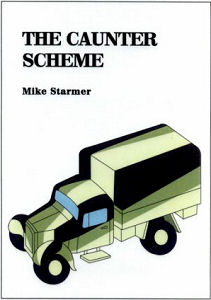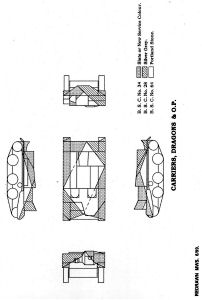 The Caunter Scheme
The Caunter Schemeby Mike Starmer
Review by Peter Brown
Named after the officer who is credited with devising it, the "Caunter Scheme" is the term used by modellers to describe the three-colour straight-edged camouflaged system used on British vehicles in the Middle East in 1940 and 1941.
In the past it has been widely misinterpreted, often using photos published in books which are not clear enough to show where the different colour bands started and ended as well as basing the colours on colour photos which may not show the shades as accurately as modern processes allow. As a result, models and preserved vehicles have appeared in a variety of styles and colours which have been copied around until they have become accepted as fact.
Mike Starmer has been researching British vehicle colours for many years, he has published a series of books which are regularly quoted in articles as well as British Army Colours and Disruptive Camouflage in the United Kingdom, France and N.W.Europe, 1936-1945 reviewed here. As with all serious researchers he is always searching for new material, this results in revisions to include new information which comes to light.
This is the case with this book which is the latest of several editions.
Back in 1999 there was a limited-edition version with plain cover and my reference book collection also includes the 2005 revision of the 2004 edition. Looking at these side by side, the size has steadily increased, the page count of the new edition is 26 including those pages with illustrations which are not numbered. Comparing this new edition with the 2005 version, there are revisions throughout apart from the core section which reproduces the original Military Training Pamphlet No 10, as this is source material with the orders describing the colours to be used and drawings showing the patterns on typical vehicles albeit with the text re-typed and the original drawings tidied up this is not surprising.
Alongside these original instruction are additional orders describing changes in colours and new for this edition is a whole new chapter on variations in the basic scheme which used two colours, this includes new drawings showing tanks deployed to Greece. Sample paint chips with mixing formulas are also provided for the colours used, these being two shades of "sand" or Stone and, the basic G3 shade used on British vehicles in the early-war years plus three different additional colours used for different areas. Also provided are additional details of how the scheme was applied, there were variations as vehicles were painted and re-painted by hand with varying levels of skill and materials.
What this book does give is the original patterns and colours which modellers, vehicle owners and museums can use as the basis for accurate schemes in association with original photos. The author has made this available by publishing it himself in spiral-bound format. Quality is steadily improving with a laminated cover for this edition but anyone expecting glossy paper and pretty binding will not find it here. However, this is a book for the serious enthusiast to keep near their working area, not to look good on the bookshelf.
Copies can also be bought direct from the author at 18 Hillside Road, Piddington, Northants, NN7 2DB, England Price including postage within the UK is £12.00 with overseas orders at £13.00 Overseas buyers would be advised to email the author direct on michael_starmer@hotmail.com if they want to buy this or the other books in this series - Desert Colours: Alamein and After 1942-43, Middle East Colours: Sicily and Italy 1943-45 and British Army Colours and Disruptive Camouflage in the United Kingdom, France and N.W.Europe, 1936-1945 - which are available at the same prices as this new edition.
In addition a few specialist outlets carry this book, those based in the UK who attend shows could see it at Bull Models while White Ensign Models or Aviation and Military Books offer them by mail order as well as at shows.






Please to help the reviews continue, thank you

